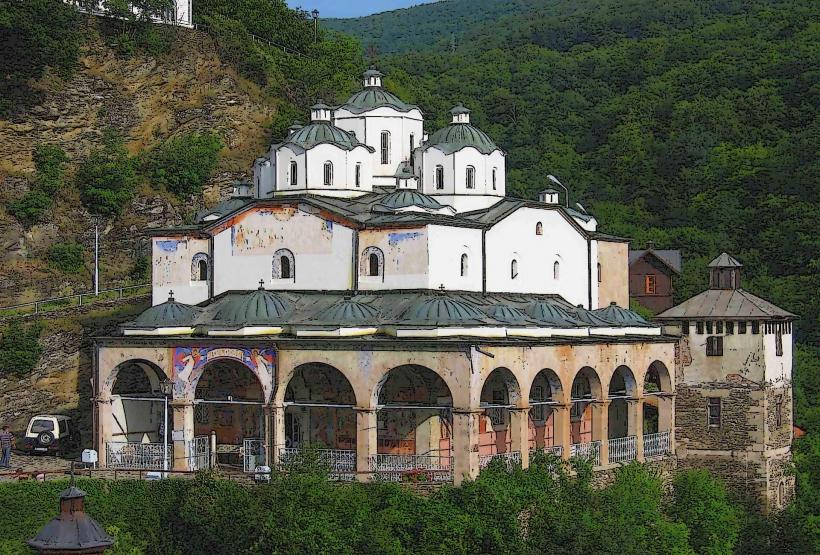Information
Landmark: Kriva Palanka FortressCity: Kriva Palanka
Country: North Macedonia
Continent: Europe
The Kriva Palanka Fortress (also known as Kale Fortress) is an ancient historical site located in Kriva Palanka, a town in the northeastern part of North Macedonia, close to the border with Bulgaria. This fortress is one of the significant landmarks in the region, offering both historical and scenic value due to its strategic location on a hill that overlooks the town and surrounding areas.
Location:
- Kriva Palanka is situated in a valley surrounded by mountains, making the Kriva Palanka Fortress a commanding presence in the region.
- The fortress itself is positioned on a hill, offering a panoramic view of the town, the nearby Kriva River, and the surrounding natural landscapes. Its location also had military significance, as it could oversee and control the surrounding area.
Historical and Archaeological Significance:
Origins and Historical Use:
- The Kriva Palanka Fortress has a long history dating back to antiquity, with some sources suggesting that it might have been used as a fortified settlement during the Roman period. However, it became more prominent during the Byzantine and Ottoman periods, serving as a military stronghold and as part of a defense network in the region.
- The fortress has gone through various stages of construction and rebuilding, depending on the ruling powers at the time. It was likely used to defend the settlement and control trade routes that passed through the valley.
Byzantine and Ottoman Influence:
- During the Byzantine era, the fortress was strengthened and expanded as part of the empire's defense strategy. The Byzantine Empire had numerous fortresses in the Balkans to protect its eastern borders from invasions.
- In the Ottoman period, the fortress continued to be a strategic military site, and the Ottomans likely used it to control access to the Kriva Palanka valley and ensure the stability of the region.
Architectural Features:
- The Kriva Palanka Fortress is primarily known for its defensive architecture, which includes thick stone walls, towers, and fortifications designed to protect the inhabitants and the town below.
- The structure of the fortress includes remains of gates, bastions, and defensive walls, which are typical of medieval fortresses.
- Artifacts such as coins, pottery, and tools found at the site point to its long history of occupation and use over centuries.
Strategic Importance:
- The fortress played a role in protecting the Kriva Palanka region, which was historically an important trade route and crossing point between the territories of modern-day North Macedonia and Bulgaria. Control over such routes was essential for military and economic purposes.
- The fortress also had an important role in monitoring and defending against potential invasions from the north and south, depending on the dominant empire at the time.
Excavation and Preservation:
Archaeological Excavations:
- The Kriva Palanka Fortress has been the subject of ongoing archaeological research, with excavations revealing key information about its construction and use over the centuries. Findings have included ceramics, coins, and military equipment, which provide insights into the daily life and strategic importance of the site.
- Researchers have also uncovered elements of Byzantine and Ottoman architecture, which showcase the different stages of construction and renovation at the fortress.
Restoration Efforts:
- Although the fortress has suffered from the passage of time and natural erosion, efforts have been made to preserve and protect the site. The Kriva Palanka Fortress is part of the region's cultural heritage, and initiatives to restore and maintain it are aimed at preserving the historical integrity of the site for future generations.
- Restoration has focused on maintaining the walls, towers, and other key features of the fortress to ensure they remain stable and recognizable to visitors and researchers alike.
Cultural and Touristic Value:
- Tourism:
- The Kriva Palanka Fortress is a popular destination for both local and international tourists interested in history, archaeology, and military architecture. Its strategic location offers stunning views of the surrounding mountains and valley, making it a scenic spot for visitors.
- Tourists can explore the remains of the fortress, walk along its defensive walls, and enjoy panoramic views of the town and the Kriva River. The fortress is also close to other cultural and natural attractions in the region, making it a key part of the local tourist circuit.
- Cultural Significance:
- The fortress is an important cultural landmark for Kriva Palanka and the wider North Macedonia region, symbolizing the area's historical depth and strategic importance in the past. It serves as a reminder of the Roman, Byzantine, and Ottoman influences that shaped the region.
- In addition to its military and architectural value, the fortress is an integral part of the local identity and pride. It hosts local events and educational programs related to the region’s history, helping to foster a sense of connection to the past.
Conclusion:
The Kriva Palanka Fortress is a valuable historical site that offers a glimpse into the military, cultural, and architectural history of North Macedonia. Its long history, from its Roman origins to its role during the Byzantine and Ottoman periods, showcases the strategic importance of the region. Today, it serves as a popular destination for both history enthusiasts and tourists, who come to explore its ruins, enjoy scenic views, and learn about the region's rich past.


